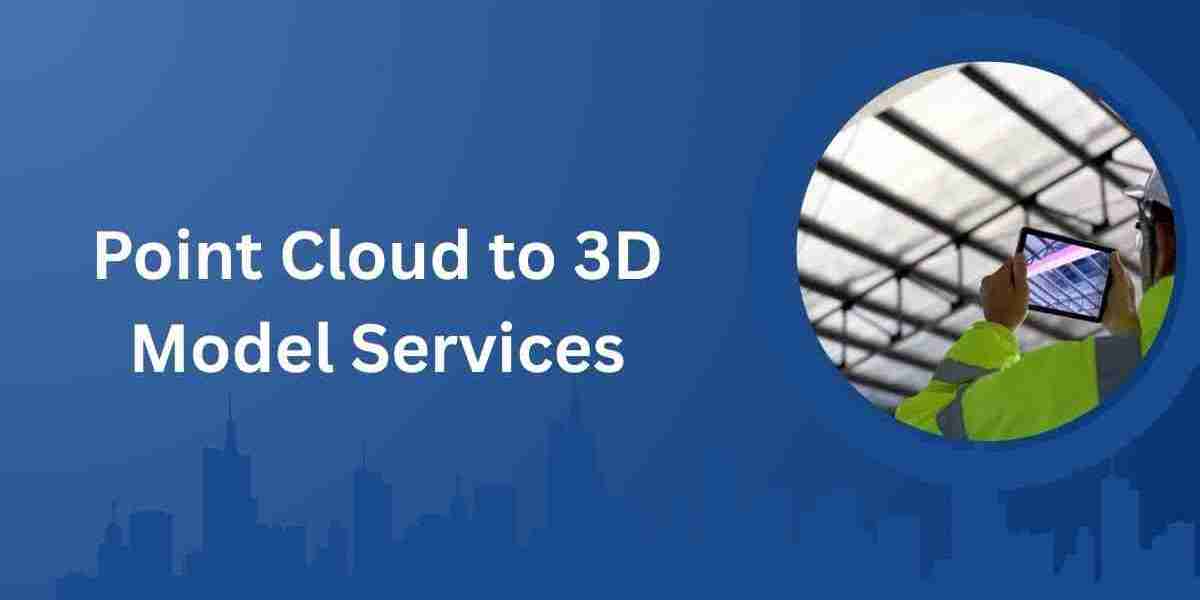Point Cloud to 3D Model Services for Experts
In today’s data-driven world, precision and accuracy are vital. Industries such as architecture, construction, manufacturing, and engineering are increasingly relying on advanced 3D modeling techniques to ensure their projects are successful. One technology gaining rapid traction is the conversion of Point Cloud to 3D Model Services, which provides detailed, accurate, and interactive visualisations. This process bridges the gap between raw scan data and usable design models, enabling efficient planning and execution.
What Is a Point Cloud?
A point cloud is a collection of data points in 3D space, typically captured using 3D laser scanners or photogrammetry technologies. Each point has a specific X, Y, and Z coordinate and represents the surface of an object or environment.
These points can number in the millions or even billions, forming a comprehensive digital representation of physical spaces. From historical buildings to large construction sites, point clouds are used to preserve spatial data with unmatched accuracy.
The process of generating a point cloud begins with a laser scanning device like LiDAR or a structured light scanner. These tools measure the time it takes for light to bounce back from surfaces to determine the exact position of each point. When multiple scans are combined, they create a complete 3D representation of the environment. This scanned data can then be processed and transformed into accurate 3D models for various applications.
Why Convert Point Cloud to 3D Model Services?
While point clouds are incredibly detailed, they’re not very user-friendly. They can be difficult to interpret, manipulate, or integrate into design software without proper processing. That’s where point cloud to 3D model services come into play. These services take raw scan data and convert it into usable 3D models such as BIM (Building Information Model), CAD files, or mesh models.
The benefits of converting point clouds to 3D models are numerous. First, it enhances collaboration among project stakeholders by providing easy-to-understand visuals. Second, it streamlines the design and planning process. Third, it improves accuracy and reduces errors in construction or manufacturing by ensuring that models are based on real-world data. Lastly, it simplifies renovations or restorations by offering a clear, digital version of the existing structure.
The Process of Converting Point Cloud to 3D Model Services
The conversion process typically involves several key steps, each designed to clean, structure, and transform raw data into usable 3D models. Here’s a breakdown of the workflow used by point cloud to 3D model services:
1. Data Acquisition
Everything begins with the scanning phase, where laser scanners capture detailed spatial data. Depending on the complexity and size of the environment, this may require multiple scanning sessions. The equipment used includes terrestrial laser scanners, mobile mapping systems, drones, and photogrammetry setups.
2. Registration and Alignment
Multiple scans need to be registered and aligned to create a unified point cloud. This is done through software tools that detect overlapping areas and stitch them together, ensuring seamless integration of all scans. Proper alignment is essential for ensuring geometric accuracy.
3. Noise Reduction and Cleaning
Raw point cloud data often contains unwanted noise such as stray points, duplicates, or misread surfaces. This data must be cleaned before modeling can begin. Techniques such as filtering, decimation, and smoothing are used to optimize the data and prepare it for modeling.
4. Segmentation and Classification
Once the cloud is cleaned, the next step is segmenting it into components. For example, walls, doors, windows, floors, and machinery might be identified and tagged. This classification allows for easier modeling, particularly when converting into BIM formats.
5. 3D Modeling
With the clean, segmented data, professionals then use software like Revit, AutoCAD, Rhino, or SketchUp to create detailed 3D models. Depending on the application, the model might be a solid object, a mesh, or a surface model. Accuracy is key here—models should be faithful representations of the scanned environment.
6. Quality Assurance and Delivery
Before delivering the final model, thorough quality control checks are performed. These ensure the model aligns with project specifications and that measurements match the scanned environment. Once verified, the final files are delivered in the desired formats.
Types of 3D Models Generated from Point Clouds
Different industries require different types of 3D models, and point cloud to 3D model services are equipped to handle all of them. Here are some common model types:
BIM (Building Information Modeling)
BIM models are rich in both geometry and metadata. They are widely used in architecture, engineering, and construction (AEC). These models help teams plan, design, construct, and manage buildings and infrastructure efficiently.
CAD Models
CAD models focus on precise geometric representation, making them ideal for engineering and manufacturing applications. These are used to create blueprints, fabrication guides, and simulation environments.
Mesh Models
Mesh models consist of interconnected vertices, edges, and faces. These are commonly used for visualization, simulation, and 3D printing. They are lightweight compared to BIM or CAD models but can still capture high levels of detail.
Industries That Benefit from Point Cloud to 3D Model Services
The versatility of point cloud to 3D model services means they’re applicable across a wide range of industries. Here are some key sectors that benefit from this technology:
Architecture and Construction
Architects and builders use point cloud modeling to capture as-built conditions, reducing errors during renovations or new builds. It helps them validate plans, simulate designs, and meet regulatory compliance.
Civil Engineering and Infrastructure
For roads, bridges, tunnels, and utilities, accurate models ensure better planning and safety. Engineers use these models to analyze structural integrity and streamline maintenance work.
Manufacturing and Industrial Plants
Plant managers use 3D models for asset documentation, retrofitting, and layout planning. Models help in managing space, equipment, and utilities without interrupting operations.
Heritage and Archaeology
3D models allow historians and archaeologists to digitally preserve heritage sites, enabling remote study and restoration without damaging the original structure. It also opens new avenues for tourism through virtual experiences.
Real Estate and Facility Management
Facility managers can use 3D models for space management, safety planning, and operational efficiency. Real estate developers use them for marketing purposes with interactive 3D tours.
Key Software Used in Point Cloud to 3D Model Conversion
Several software platforms specialize in handling point cloud data and converting it into high-quality 3D models. Here are some industry favorites:
Autodesk Revit – Popular for BIM modeling from point clouds.
AutoCAD – Ideal for 2D and 3D CAD drafting and modeling.
Leica Cyclone – A powerful tool for point cloud processing and registration.
FARO SCENE – Used for managing and visualizing 3D scan data.
Trimble RealWorks – Great for extracting features and modeling structures.
CloudCompare – Open-source and widely used for cleaning and aligning scans.
Rhino + Grasshopper – Excellent for advanced geometry and parametric design.
Challenges in Converting Point Cloud to 3D Model Services
Despite its advantages, point cloud to 3D model conversion comes with challenges. These include:
Data Volume and Processing Time
Point clouds can be extremely large, sometimes over 100 GB per project, requiring powerful hardware and storage. Processing this data can be time-consuming.
Complexity in Irregular Geometries
Historical buildings, landscapes, or organic forms often have irregular shapes that are hard to model. This demands expert-level understanding of geometry and software capabilities.
Accuracy and Human Error
Small mistakes during registration or modeling can lead to significant inaccuracies. Quality control is essential, and experienced professionals are needed for precision work.
Software Compatibility
Some modeling software may not fully support certain point cloud formats or may have limited capability in handling large datasets. File conversions and exports must be managed carefully.
Choosing the Right Service Provider
When looking for a point cloud to 3D model service provider, keep these factors in mind:
Experience and Portfolio – Check past projects and client testimonials.
Software Proficiency – Ensure they use industry-standard tools.
Accuracy and Quality Assurance – Look for stringent QA processes.
Scalability – Can they handle large and complex projects?
Turnaround Time – Ask about delivery timelines and workflow structure.
Customer Support – Ensure ongoing communication and support are available.
Conclusion
Point cloud to 3D model services are revolutionizing how industries design, manage, and interact with physical environments. From improving construction accuracy to enabling digital preservation, the benefits are vast. As the technology evolves, its adoption will only grow, making it a cornerstone of modern digital transformation efforts.
Whether you're working on a commercial skyscraper, a power plant, or a historical restoration, leveraging this service can save time, reduce cost, and enhance decision-making. Choosing the right partner to handle your data and deliver top-notch 3D models is the first step toward smarter, more efficient project execution.
Read more: Affordable Pool Construction in Knoxville Without Sacrificing Quality







